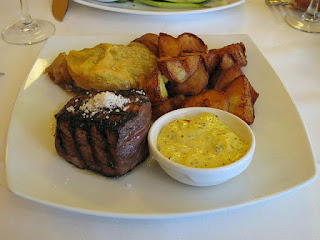But first, here's Tim's diagram again:
In order to understand this cryptic answer, let's go back to a diagram I had on my Facebook.com/pairteas page:
The ovals in this diagram shows three different types of cells in taste buds.
- Type III cells (yellow, on the right) have at least two functions: first, they send the final taste messages to the nerve that in turn send the message to the brain; second, they sense sour from aicids such as citric, acetic, and lactic acid (more about this function below)
- Type I cells (grey, on the left) respond to salt. When salt arrives on their surface, they stop bitter-sensing Type II cells from sending the "bitter" message to Type III cells. That's why Tim advocates a touch of salt to inhibit the bitterness of the tannins in wine. Inhibition of bitterness also inhibits astringency—will explain this point in a future post. Suffice it to say here that the perception of astringency requires activation of the bitter receptor.
- Bitter, sweet, and umami molecules bind to receptors on Type II cells (the three cells in the middle). Note that each individual cell responds to only one of these three kinds of tastants.
- At high concentrations of sweet, activated Type II cells for sweet can turn off Type II cells responsive to bitter.
- Type II cells that respond to bitter compounds inhibit the response of Type II cells that respond to sweet. That's why you can't taste sweet when you eat something bitter unless you add a enough sweetness to overcome the bitterness blockade. That's a lot of sweetness! Or...if you add salt! Now bitterness is inhibited, so any sweetness present in the food or beverage has a chance to come to the fore.
- Finally Type III cells (yellow, on the right) do at least two things, as mentioned before: they respond to signals from Type II cells, and pass the message (sweet, bitter, umami) on to the taste nerves. BUT when sour compounds such as acetic acid (wine/vinegar), lactic acid (wine) or citric acid (from citrus fruits like lemon) are present, these cells inhibit Type II cells from sending messages of bitter, sweet, and umami.
The key words in the previous bullet point is "when sour compounds are present." As I noted in a previous post (WEDNESDAY, FEBRUARY 17, 2016), the sour receptor is an "off" receptor. In other words you taste sour after the cell no longer brings the acid into itself because the concentration of acid outside the cell has dropped. However, the important point is that messages from the bitter, sweet and umami Type II cells are inhibited the moment acid enters Type III cells. Once the sour is diluted by saliva, the sweet and umami have a chance to come through, and there is even a rebound increase in sweet. Note that salt will inhibit bitter independently of sour, as does sweet, though more sweet than salt is needed to be effective.
That's why, by having a bite of something that is salty and mildly acid, such as a piece of steak with a good dollop of Béarnaise sauce—or something more intensely sour, such as a lemon (which induces massive salivation) along with some salt—before you take a sip of the wine, the wine will be diluted, sourness will be gone, and your taste buds will be ready to appreciate the sweetness and fruitiness in the wine, characteristics that had been hidden by the wine's tannins and acid.
Image from Wikipedia:
Strip steak with tatin of shallots and bearnaise sauce.
Restaurant "les Ministères", 30 rue du Bac, Paris 7th arrond.
Notice the salt on top of the steak! Just imagine the wine...or the tea!
Conversely, if you start with something sweet, such as a highly sugared dessert, or a high umami food such as a piece of steak plain with no sauce or salt, and then drink the wine, the acidity of the wine will immediately turn off your ability to sense the food's sweetness and umami. The result is that the wine will taste extra dry, and as you salivate the wine will taste extra sour and bitterness and astringency will come through.



No comments:
Post a Comment